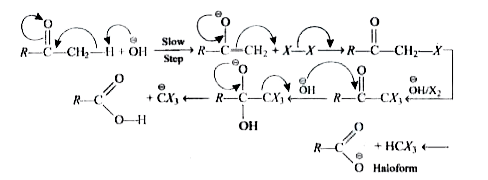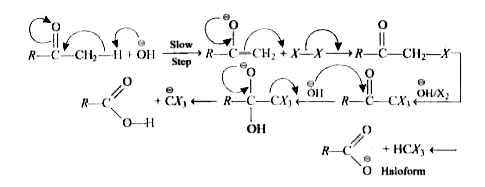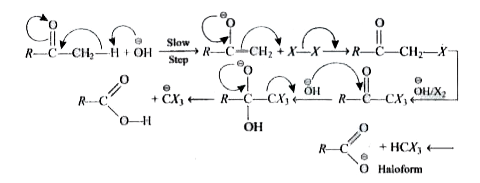Compound Ph−O−O∣∣C−Ph can be prepared by the reaction of
Phenol and benzoic acid in the presence of NaOH
Phenol and benzoyl chloride in the presence of pyridine
Phenol and benzoyl chloride in the presence of ZnCl2
Phenol and benzaldehyde in the presence of palladium.
The correct Answer is:B
To prepare the compound Ph−O−C(=O)−Ph, which is an ester, we can follow these steps:
Step 1: Identify the Reactants
The compound consists of a phenyl group (Ph) attached to an oxygen atom, which is then connected to a carbonyl group (C=O) and another phenyl group. This indicates that the compound is an ester formed from phenol and benzoic acid.
Step 2: Write the Reaction
The reaction involves the esterification process between phenol (C6H5OH) and benzoic acid (C6H5COOH). The general reaction for ester formation can be represented as:
\( \text{Phenol} + \text{Benzoic Acid} \rightarrow \text{Ester} + \text{Water} \)
Step 3: Mechanism of Esterification
1. Protonation of the Alcohol: In an acidic medium, the hydroxyl group of phenol can be protonated to form a better leaving group.
2. Nucleophilic Attack: The phenol (now protonated) acts as a nucleophile and attacks the carbonyl carbon of benzoic acid.
3. Formation of Tetrahedral Intermediate: This leads to the formation of a tetrahedral intermediate.
4. Elimination of Water: The tetrahedral intermediate collapses, leading to the elimination of water and the formation of the ester.
Step 4: Final Product
The final product of this reaction is the ester Ph−O−C(=O)−Ph (phenyl benzoate) along with the release of water.
Conclusion
Thus, the compound Ph−O−C(=O)−Ph can be prepared by the reaction of phenol and benzoic acid in the presence of an acidic medium or basic medium.
---
The compound consists of a phenyl group (Ph) attached to an oxygen atom, which is then connected to a carbonyl group (C=O) and another phenyl group. This indicates that the compound is an ester formed from phenol and benzoic acid.
The reaction involves the esterification process between phenol (C6H5OH) and benzoic acid (C6H5COOH). The general reaction for ester formation can be represented as:
\( \text{Phenol} + \text{Benzoic Acid} \rightarrow \text{Ester} + \text{Water} \)
1. Protonation of the Alcohol: In an acidic medium, the hydroxyl group of phenol can be protonated to form a better leaving group.
2. Nucleophilic Attack: The phenol (now protonated) acts as a nucleophile and attacks the carbonyl carbon of benzoic acid.
3. Formation of Tetrahedral Intermediate: This leads to the formation of a tetrahedral intermediate.
4. Elimination of Water: The tetrahedral intermediate collapses, leading to the elimination of water and the formation of the ester.
The final product of this reaction is the ester Ph−O−C(=O)−Ph (phenyl benzoate) along with the release of water.
Thus, the compound Ph−O−C(=O)−Ph can be prepared by the reaction of phenol and benzoic acid in the presence of an acidic medium or basic medium.
Topper's Solved these Questions
- ALDEHYDES, KETONES AND CARBOXYLIC ACIDSBook:ICSEChapter:ALDEHYDES, KETONES AND CARBOXYLIC ACIDSExercise:EXERCISE (PART-II DESCRIPTIVE QUESTIONS) (VERY SHORT QUESTIONS)
Explore 282 Videos
- ALDEHYDES, KETONES AND CARBOXYLIC ACIDSBook:ICSEChapter:ALDEHYDES, KETONES AND CARBOXYLIC ACIDSExercise:EXERCISE (PART-II DESCRIPTIVE QUESTIONS) ( SHORT QUESTIONS)
Explore 581 Videos
- ALDEHYDES, KETONES AND CARBOXYLIC ACIDSBook:ICSEChapter:ALDEHYDES, KETONES AND CARBOXYLIC ACIDSExercise:EXERCISE (PART-II DESCRIPTIVE QUESTIONS) ( LONG ANSWER QUESTIONS)
Explore 478 Videos
- ALCOHOLS, PHENOLS AND ETHERS Book:ICSEChapter:ALCOHOLS, PHENOLS AND ETHERS Exercise:ISC EXAMINATION QUESTIONS
Explore 25 Videos
- APPENDIX II ( TYPICAL CONVERSIONS)Book:ICSEChapter:APPENDIX II ( TYPICAL CONVERSIONS)Exercise:AROMATIC CONVERSIONS
Explore 98 Videos
Similar Questions
Knowledge Check
CH3−O∣∣C−H and Ph−O∣∣C−H can be differentiated by :
ATollen's reagentBFehling's solutionCLucas reagentDVictor meyer's testCompound having −O∣∣C−CH3 group reacts rapidly with halogen in presence of a base to form haloform. The reaction is known as haloform.
R−O∣∣C−CH3X2+ϴOH−−−−→R−O∣∣C−ϴO+CHX3
Mechanism

Consider the following reactions:
Reaction I →Ph−O∣∣C−CH3Cl2,ϴOH−−−−→Ph−O∣∣C−ϴO+CHCl3
Reaction II →Ph−O∣∣C−CD3−Cl2,ϴOH−−−−→Ph−O∣∣C−ϴO+CDCl3
Which of the following is correct comparison of the rate of reaction I and II?ArI>rIIBrI>rIICrI=rIIDCannot be determinedMixture of Ph−O∣∣C−H and HCHO is treated with NaOH then Cannizzaro reaction involves
Areduction of HCHOBoxidation of HCHOCreduction of PhCHODoxidation of PhCHO
Ph−O∣∣C−CH3+CH2=O(excess)OHΘ−−→Ph−O∣∣C−C(CH2OH)3
In the above reaction how times of aldol reaction takes place ?
View SolutionWrite the systematic IUPAC names of the following compounds :
H−O∣∣C−O∣∣C−H
View SolutionCompound having −O∣∣C−CH3 group reacts rapidly with halogen in presence of a base to form haloform. The reaction is known as haloform.
R−O∣∣C−CH3X2+ϴOH−−−−→R−O∣∣C−ϴO+CHX3
Mechanism

Which of the following will yield iodoform on reaction with I2+NaOH?
View SolutionCompound having −O∣∣C−CH3 group reacts rapidly with halogen in presence of a base to form haloform. The reaction is known as haloform.
R−O∣∣C−CH3X2+ϴOH−−−−→R−O∣∣C−ϴO+CHX3
Mechanism


Which of the following is correct comparisonof rate of haloform reaction with various halogens?
View SolutionR−O∣∣C−O−R'+R''OHH⊕⇐⇒R−O∣∣C−O−R''+R'OH
Above reaction is/an example of
View Solution